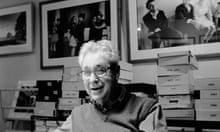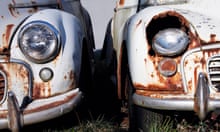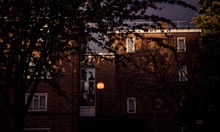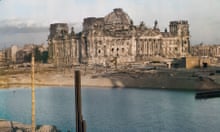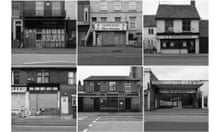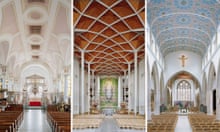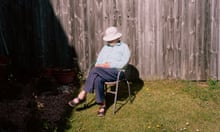On a summer day in June 1994, Kate Moss, then just 20, and the British photographer Glen Luchford set out across New York for a reportage-fashion shoot that indelibly captured the energy and beauty of the young model, in love and on the brink of great fame, and the energy and light of a city that was similarly about to change.
Dozens of images from that shoot, which took place over a day and used more than 200 rolls of film, have now been published in Roseland, out now from Idea Books, and named after the midtown ballroom that had hosted the orchestras of jazz-age greats Louis Armstrong and Count Basie.
Like that music, the images capture the purity of another era – a day in New York, the grit and the beauty, the sexy and the sex. And they marked the extraordinary moment Moss, who turns 50 next month, was propelled into the fashion stratosphere as the most influential supermodel of her generation.
“It’s as much a book about New York as it is about Kate,” Luchford tells the Observer. “I’d seen Taxi Driver and was really excited that the city still looked like that. But I realised that New York was changing and I wanted to capture it. So we went out on to the streets, went crazy, and that’s what came out.”

Months earlier, Luchford had been lending Moss taxi money to get home to Croydon. Now in New York, Moss’s famous Calvin Klein ads were up in Times Square. “New York can be so fast the way it can inject someone’s career. She’d been sent over to see Steven Meisel and Calvin, and went home on Concorde. She’d made it [in] one week. It was a pretty amazing, fun moment we all participated in.”
But the shoot was not successful at the time. Harper’s Bazaar, then under the editorship of Liz Tilberis, had ordered colour pictures – black and white, along with any hint of underwear or nipple, was unpublishable. Luchford, says stylist Sciascia Gambaccini, stuck to his guns. “I told him we have to shoot colour or they’ll kill us. But he said he’d never shot colour in his life.”

The group, including makeup artist Kay Montano, set off in a camper van around New York with a friend of photographer Mario Sorrenti, who gave Moss impromptu boxing lessons. The caravan visited Times Square and the Hotel Chelsea, as well as nearby side-street sex shops.
“It was the gritty New York, the kind of city that Glen wanted to discover and be excited about,” Gambaccini recalls. “And Kate was exactly at the moment she was exploding in the US. She had just started going out with Johnny Depp and was all starry eyed.” Gambaccini and Moss had been in Mexico, and Moss had insisted on stopping off in Dallas on the way home to buy a Stetson hat.
“I said OK. We stopped and got a hat. I had a bag of clothes, sequined clothes, all mismatched. So I said, ‘You keep the hat on and we’ll just shoot you with it – you’re in a cowboy hat in New York.’” Then they just had to follow their model and, Gambaccini posted on Instagram, “dance to her rhythm”.

But there something more to the pictures – the faces, sights and attitude of a New York that no longer exists. In his book Times Square Red, Times Square Blue, literary critic Samuel R Delany described the changes and creeping social detachment that took place in the community around Times Square, then about to be sanitised by mayor Rudy Giuliani with the help of Disney and other entertainment giants. “In the rush to accommodate the new, much that was beautiful along with much that was shoddy, much that was dilapidated with much that was pleasurable, much that was inefficient with much that was functional, is gone,” Delany wrote.
after newsletter promotion
Luchford recalls first venturing into this realm that Delany described as “a complex of interlocking systems and subsystems”. “It caught my imagination,” he says. “I went to Times Square to see RoboCop. There was a prostitute sitting behind me giving a blow job, a guy to my right smoking crack. I think what was most shocking was that every time RoboCop shot someone, everyone in the theatre started cheering, joining in with the movie, which you’d never get in England.”

The pictures Luchford and Gambaccini handed in weren’t well received. “I was thrilled but I got fired from the magazine straight away and not booked again,” Luchford recalls. “I was a bit wounded but now I kind of understand … I was just taking pictures and not paying attention to the fashion at all.”
“The editors said, ‘Oh my God, she has dirty hair, she doesn’t look clean, and the pictures are in black and white,’” Gambaccini recalls. “I was going into hospital. So I said, ‘I don’t know. These are the pictures, you guys figure it out.’” The pictures ran, but with a colour wash over them. “Then they became the example of cool 90s fashion … and all hell broke loose because editors didn’t know whether to hate it or love it.”
For Moss, too, the pictures mark a turning point. She would no longer be just Kate but Kate the supermodel, and fashion entered what Luchford calls its industrial period of corporate brands. The friends had to become more serious. “It was the last period of fun,” he says. “We were friends, laughing hysterically, drinking and smoking cigarettes. It was all very unprofessional, quite amateurish and probably why they’re great pictures. No one was taking it seriously.”


